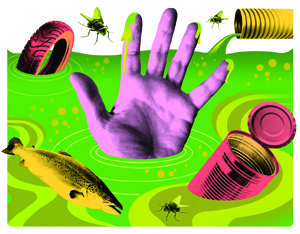
Troubled Waters
Q: How dirty is White River, really? Is it “don’t get any in your mouth” dirty or “don’t stick your hand in it without getting a tetanus shot” dirty? Jeremiah P., Brownsburg
A: A few years ago, The Hoosierist and a friend canoed White River from Broad Ripple Park to downtown. Before starting, we made a solemn vow: If one of us fell in, the other would beat that person to death with his paddle, saving him from what we assumed would be an agonizing demise from some hideous river-borne infection.
White River isn’t that bad from end to end, but it can get pretty awful in places. Kevin Hardie, executive director of the advocacy group Friends of White River, says he doesn’t worry about contact with the stretch of waterway above the Broad Ripple dam. Just wash your hands once you’re done. He’s less sanguine about the rest of the city waterway, thanks to our antiquated sewers. They handle both rainwater and sewage, and if it rains too much the system shunts raw human waste into the river. Would you like to re-create that scene in The Shawshank Redemption in which Tim Robbins crawls through a sewer pipe? Swimming in the downtown White River would come close.
So here’s the 411: Above Broad Ripple, water contact is okay, but clean up afterward. And don’t get any in your mouth. Below Broad Ripple, stay clear. Don’t even let your dog go in. And if you need further discouragement, remember that swimming in the river is actually illegal. “There’s a county ordinance against it because of concerns about drowning,” Hardie says. The water is full of foot-snagging junk, and it’s deeper and faster than it looks—especially after storms. So just stay clear. And clean.
Q: Are we going to see any more skyscrapers built downtown in the near future? Nancy K., Indianapolis
A: The Hoosierist politely directs your gaze westward, toward the looming immensity of the new JW Marriott. Though some feel its exterior boasts all the warmth of a black-granite tombstone, it certainly counts as a skyscraper—at least in these parts. At 375 feet, it’s Indy’s seventh-tallest structure.
Of course it’s only one building—a far cry from the construction boom of the 1980s, when skyscrapers sprouted like morels after a spring rain. Sadly, not much skyline-enhancing work has been done since the 49-story Chase Tower opened for business in 1990. It’s economics. Skyscrapers cost a fortune, so they usually happen during boom times. Which these are not.
Perhaps, if the economy improves, we’ll see more high-rises. In the interim, remember that while our current skyline is no great shakes compared to New York City, it’s still pretty big stuff in the Midwest. In the Heartland, only Chicago and Cleveland boast anything taller than the Chase Tower. Does that take the edge off of your edifice complex?
Q: Does Reggie Miller still live here? I see him around, but not as much as I used to. Stephanie P., Indianapolis
A: You see Reggie Miller around? Then you either move in very different circles than The Hoosierist, or you need to clean your contact lenses. The Indiana Pacers’ former standout (and current Hall of Fame contender) just doesn’t have a pressing reason to come here anymore—so he doesn’t. He put his 14,000-square-foot Geist home on the block for $7.5 million in 2007 (it’s since sold), and the last well-publicized excursion he made to these parts was in February 2010 for the Indy premiere of the documentary Winning Time: Reggie Miller vs. the New York Knicks at Conseco Fieldhouse. His links with his former team have grown pretty tenuous, too. A Pacers rep says Miller no longer consorts much with the blue and gold, and that the former standout now resides “in California somewhere.” Actually, Malibu. The Hoosierist suggests that if you really want to see old Number 31 “around,” your chances of a sighting would be better out there.
Q: Are there any concentrations of Native Americans left in Indiana? We’re named for them, after all. Gabriel H., Bloomington
A: The Hoosierist sees through your query. You aren’t concerned about the status of the 0.3 percent of Indiana’s population that classifies itself as Native American. You just want to know if there’s any chance our state might someday host a federally recognized reservation and, shortly thereafter, an Indian casino. Well, don’t hold your breath, Folds At First Call.
Indiana, in spite of its name, contains not a single federally recognized tribe. The strongest candidate for such a designation might be the Miami people, this area’s original inhabitants. In 1846, the U.S. government forcibly moved most of the tribe out west, eventually plunking them down in Oklahoma, where the majority of them remain today.
These “Western Miami” are recognized by the feds, but not the Miami who stayed behind. The Indiana legislature voted to recognize that small band, but the U.S. didn’t and probably, at this late date, never will. But this won’t stop The Hoosierist from adding his voice to the chorus demanding recognition of Indiana’s Miami people—so long as they agree to build a casino, and to place it in Miami County. Besides being the Eastern Miami’s current headquarters and the heartland of its former territory, it’s also smack in the middle of Amish country. The juxtaposition of all those carriage-riding Plain Folk with a colony of Native Americans—not to mention tax-free smokes and what will surely be the Loosest Slots In The State—would create an irresistible tourist draw. Possible chamber of commerce motto: Buy a quilt in Nappanee, lose your shirt in Peru!
Editors – this needs an illustration credit
This article originally appeared in the March 2011 issue.





